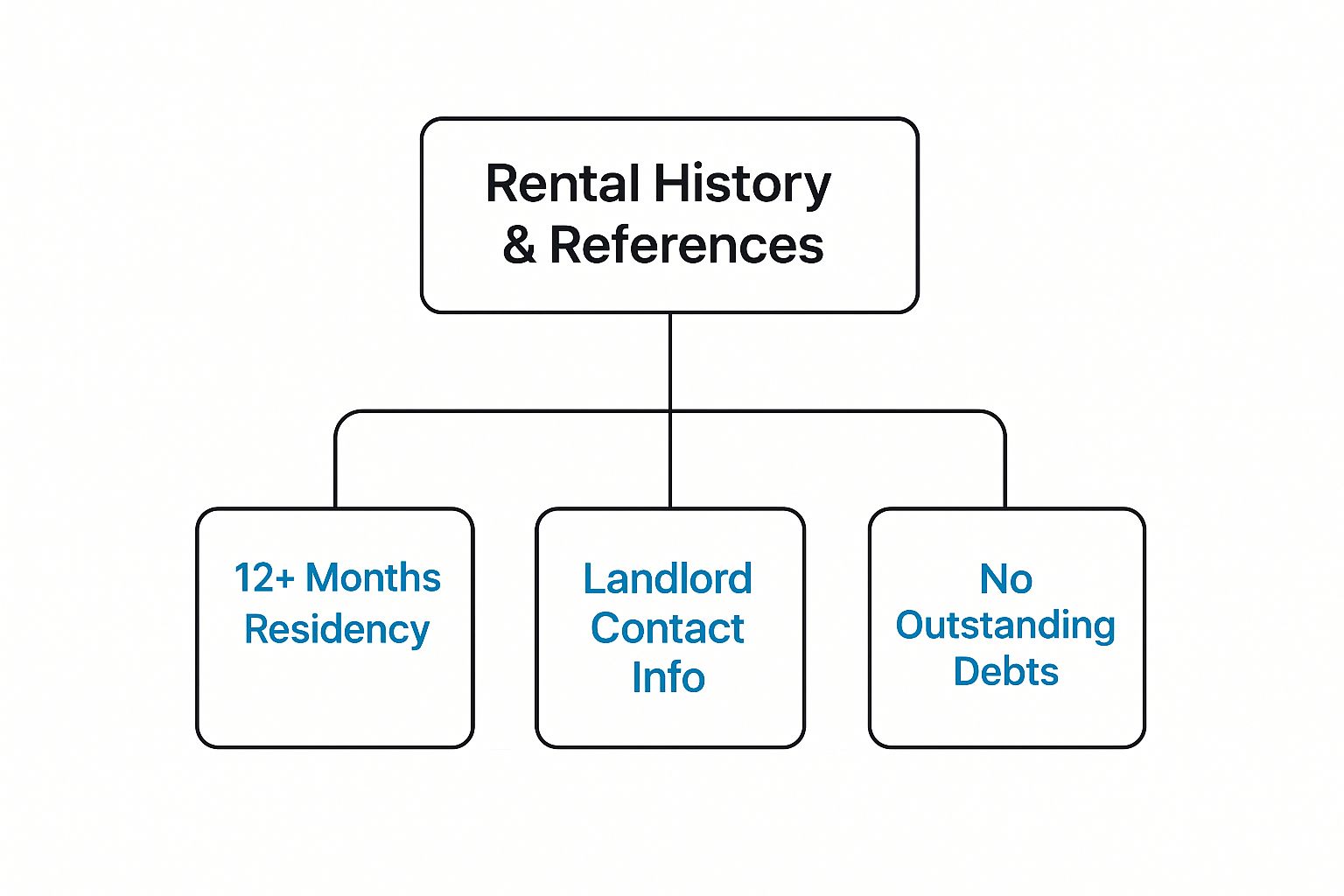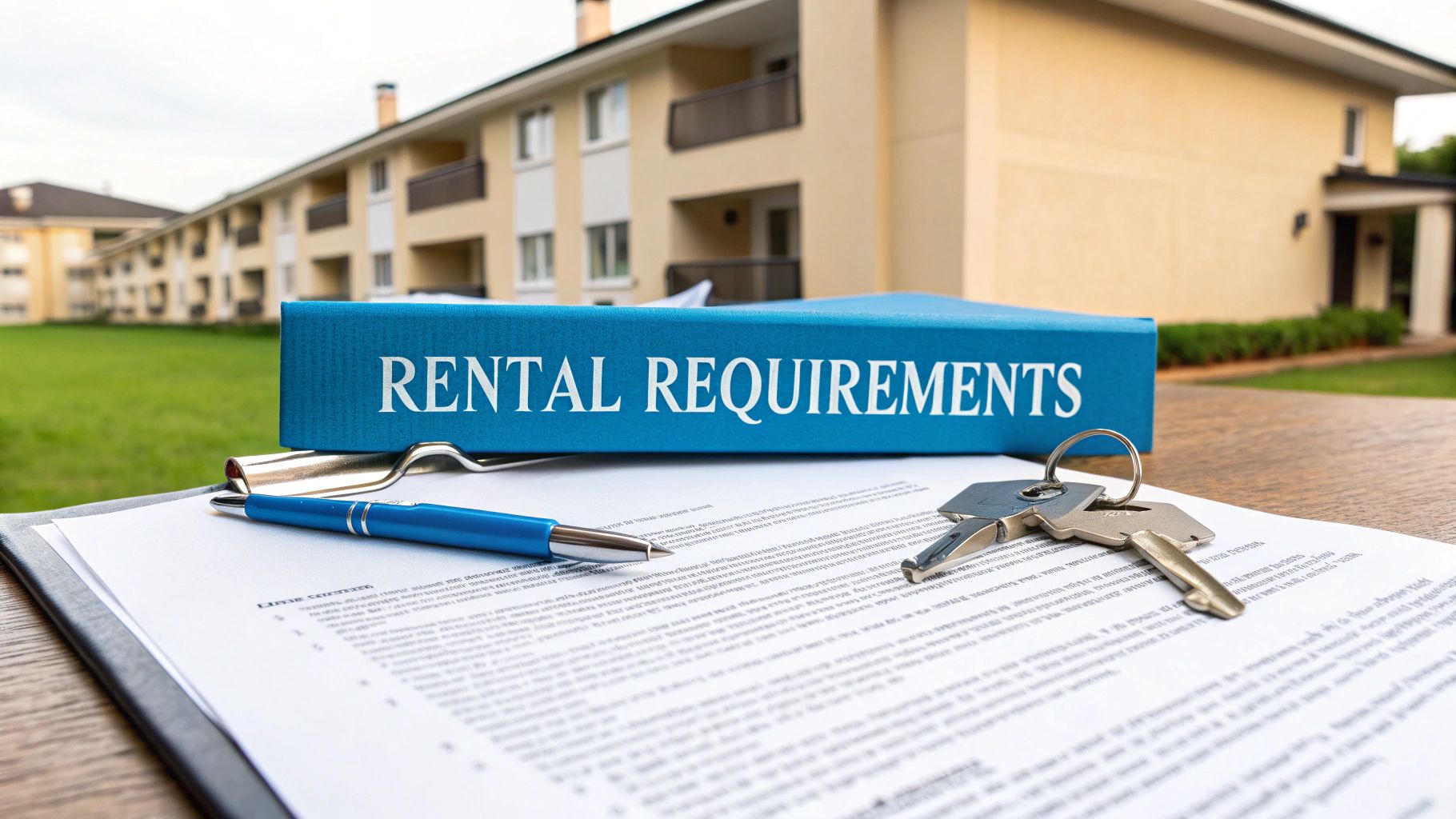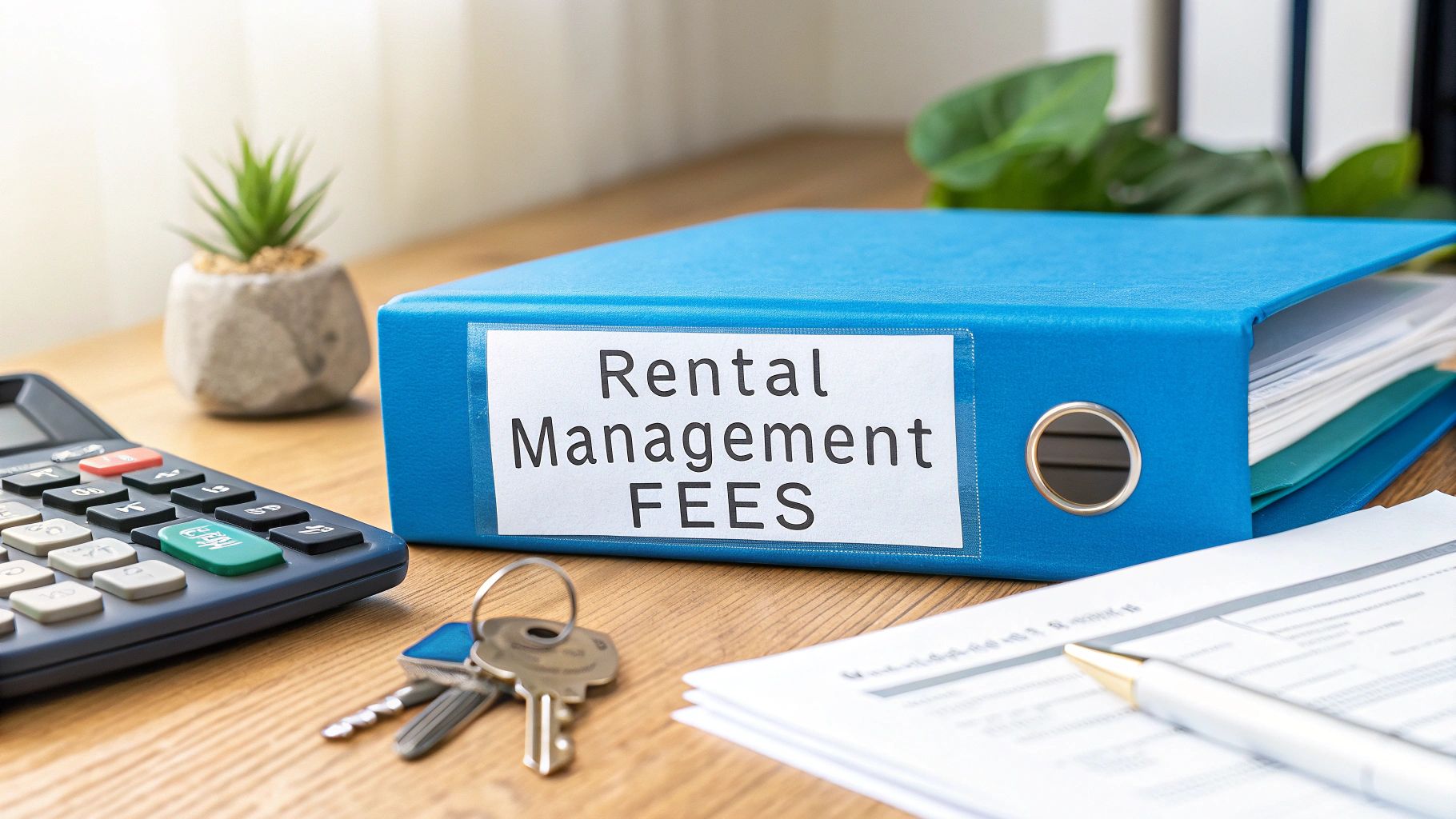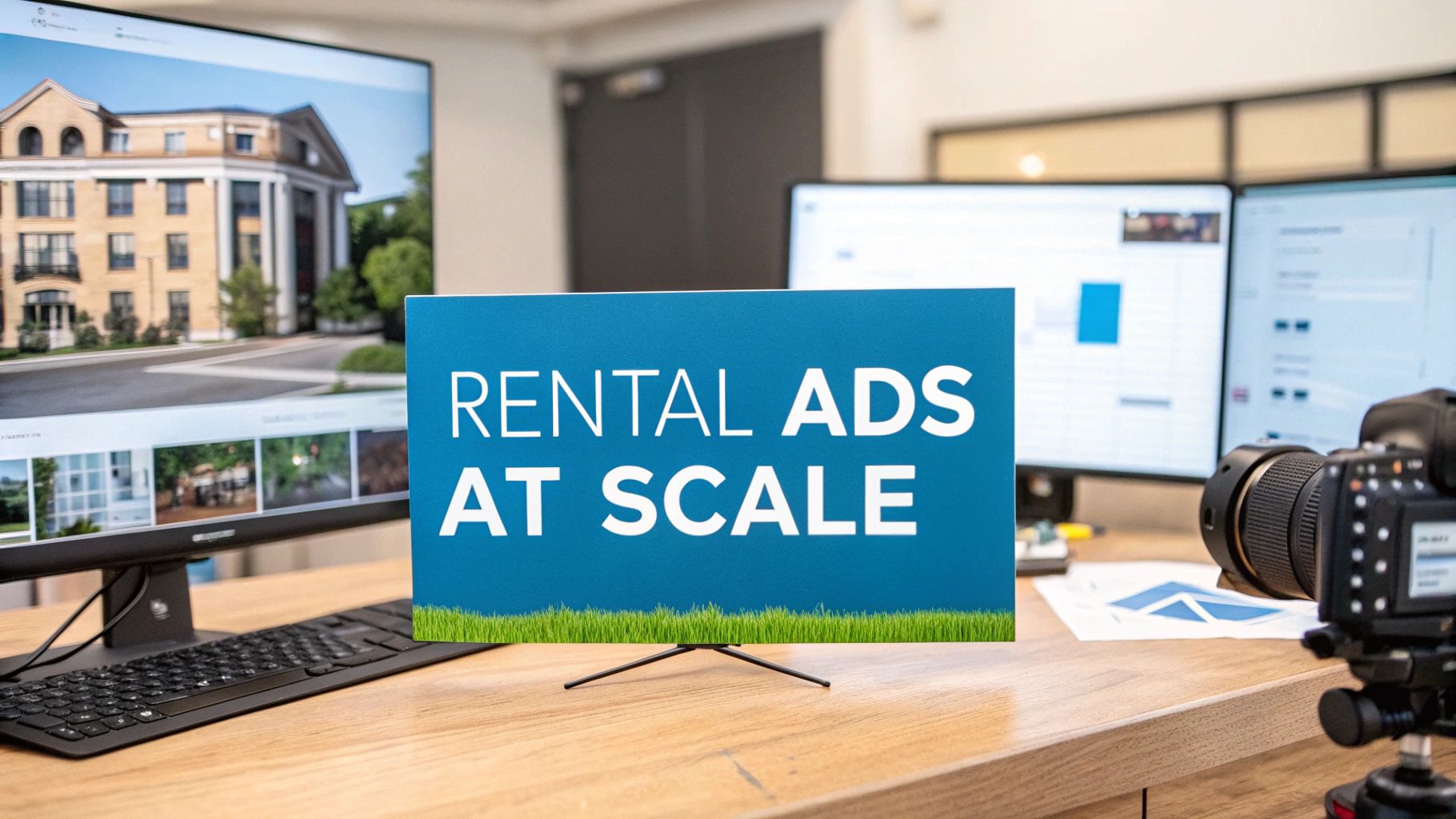When you're managing hundreds—or even thousands—of properties, a clunky, inconsistent application process is more than just an operational headache. It's a direct hit to your portfolio's revenue. Every day a unit sits empty because of a sluggish vetting process inflates your Days on Market (DOM), a critical metric representing lost revenue that multiplies quickly across a large portfolio. For a 1,000-unit portfolio with an average rent of $2,000, just one extra vacancy day costs over $66,000.
A crystal-clear, standardized set of rental application requirements is your first line of defense. It’s what protects your assets, ensures Fair Housing compliance at scale, and turns the often chaotic leasing process into a predictable, revenue-generating machine.
Why Standardized Application Requirements Matter at Scale

In large-scale property management, inconsistency is the enemy of efficiency and profitability. If leasing agents across different markets use subjective criteria to evaluate applicants, your lead-to-lease timeline stretches out, your lead-to-tour conversion rate plummets, and quality control becomes impossible. This operational drag inflates your cost-per-door and drives up vacancy loss.
Standardizing your rental application requirements transforms your leasing operation. It creates a scalable framework that empowers your entire team to make faster, data-driven decisions. You’re no longer relying on subjective guesswork; you’re turning applicant screening into a science that reduces DOM and maximizes revenue.
The Core Components of a Scalable Application Package
To build a truly scalable system, you need a uniform application process that measures every applicant against the same objective benchmarks. This isn't just about speed-to-lease—it's critical for fair housing compliance and intelligent risk management across a distributed portfolio. A robust, standardized system is the foundation for managing thousands of units remotely without a large on-site staff.
The table below outlines the essential checks that form the backbone of a comprehensive, enterprise-level tenant screening process.
These components work in concert to provide a 360-degree view of an applicant, mitigating portfolio-wide risk and ensuring every leasing decision is backed by solid data.
The Foundation of a Scalable System
Ultimately, a strong application process boils down to verifying three key things:
- Financial Stability: Can they consistently pay the rent on time?
- Rental History: Are they a responsible tenant who will protect the asset?
- Background Information: Will they adhere to legal and community guidelines?
One of the most universal requirements in the rental world is financial qualification. Landlords almost always require proof of stable income that's at least two to three times the monthly rent. In fact, over 80% of landlords in the US run credit checks, with many setting a minimum score around 620 to even be considered. You can learn more about the current state of the housing rental market here.
When you define these requirements clearly from the start, you build a system that’s not just efficient but also fair and legally defensible. This dramatically reduces your risk of dealing with costly vacancies, evictions, and legal headaches across your entire portfolio.
How to Verify Applicant Income and Employment

Consistent rent payments are the lifeblood of your portfolio's financial performance. When you're managing properties at scale, you need an income and employment verification process that's both airtight and incredibly efficient. A flimsy, manual system doesn’t just expose you to delinquencies; it drags out your lead-to-lease cycle and directly impacts revenue by increasing DOM.
Relying on old-school methods like manually reviewing pay stubs and W-2s is a significant operational gamble. It's slow, tedious, and shockingly easy for applicants to fake these documents. For a growing portfolio, this manual grind is an operational bottleneck that simply won't scale.
Adopting Modern Verification Methods
This is where tech-forward property managers gain a competitive edge. They are switching to automated verification services that integrate directly with payroll systems and financial institutions. This technology confirms an applicant's income and employment instantly and with near-perfect accuracy.
For any operator focused on scaling, this automated approach is a game-changer for key performance indicators (KPIs):
- Drastically Reduced Fraud Risk: Direct data pulls mean you’re getting verified information, not a doctored PDF. Forged documents become a non-issue, protecting your NOI.
- Faster Speed-to-Lease: Verification that takes minutes instead of days allows you to secure qualified tenants before they are lost to competitors, directly reducing DOM.
- Boosted Operational Efficiency: Your leasing team is freed from chasing paperwork, allowing them to focus on high-value activities like lead nurturing and closing leases, improving your cost-per-door.
By standardizing and automating your verification process, you’re not just checking a box. You’re implementing a reliable system that empowers your team to make rapid, data-backed leasing decisions. The result? Lower delinquency rates and a healthier bottom line.
Handling Non-Traditional Income
Not every high-quality applicant comes with a neat W-2. You’ll encounter freelancers, small business owners, and gig economy workers with a mix of bank statements, 1099s, and tax returns. Without a clear framework for these applicants, you risk rejecting excellent tenants and leaving money on the table.
The best practice is to establish a consistent, defensible framework. A great starting point is requiring two years of tax returns alongside six months of recent bank statements. This allows your team to establish a stable income average they can trust, standardizing the process across all applicant types.
Mastering this is a key part of a larger strategy. Getting a handle on prospect screening for ideal tenants ensures you're applying fair and legally defensible criteria to every single applicant, protecting your assets while keeping occupancy high.
Interpreting Credit and Criminal Background Checks
A credit report is far more than a three-digit score; it's an applicant's financial track record. For property managers overseeing large, distributed portfolios, knowing how to interpret these reports is essential for minimizing risk at scale. You have to move past a simple FICO score glance and dig into the details to understand the story it tells.
A solid credit history is a strong predictor of on-time rent payments. It signals financial responsibility. Some applicants even proactively build credit with rent payments, strengthening their application. However, a low score isn't an automatic disqualifier. The key is a standardized policy that looks for specific patterns.
Beyond the Score: A Framework for Risk Assessment
To get a true sense of financial risk, you must focus on specific data points within the report. A single late payment from several years ago is a minor detail; a recent string of defaults is a major operational risk.
Here is a framework for consistent credit review:
- Payment History: Are there recent or repeated late payments on credit cards, car loans, or other debts? This is a primary indicator of financial distress.
- Debt-to-Income Ratio: Even with a strong income, excessive debt can signal an overextended applicant who is one emergency away from delinquency.
- Public Records: Previous evictions or bankruptcies are significant red flags and are non-negotiable disqualifiers for most enterprise-level operators.
The same systematic approach applies to criminal background checks. You need a clear, consistent, and non-discriminatory policy that is defensible across all markets. This isn't about blanket denials but about assessing relevant history that could pose a genuine risk to the property or other residents. For property managers operating across multiple cities or states, this standardization is non-negotiable for navigating the complex patchwork of local "ban the box" laws.
A well-defined screening policy is your best defense against fair housing claims. Your criteria for both credit and criminal history must be applied consistently to every single applicant, without exception. This consistency shields your portfolio from significant legal and financial threats.
This process of due diligence, especially verifying rental history, can be broken down into clear, actionable steps, as this infographic shows.

As you can see, properly validating an applicant’s past tenancy means confirming tenancy duration, speaking directly with previous property managers, and ensuring there are no outstanding rental debts.
Validating Rental History and Landlord References

An applicant’s past behavior is one of the best predictors of future performance. How they treated their last rental is a clear signal of how they'll treat your asset. That's why building a rock-solid, scalable process for checking rental history isn't just a "nice-to-have"—it's a core part of your rental application requirements and risk mitigation strategy.
For any portfolio manager, this step is all about protecting asset value. A single bad tenant can cause thousands in damages or lost rent from a lengthy eviction. Multiplied across a large portfolio, the financial impact on your NOI can be catastrophic. The goal here is simple: get an honest, unfiltered look at their payment habits and property care directly from the people who know best.
The Standardized Reference Check Process
To maintain objectivity and compliance, your team must ask every previous landlord the same set of questions. This isn't about getting a vague "they were great!"—it's about creating a scalable, defensible system for making decisions based on facts, not subjective feelings.
Here’s a checklist of what you must verify:
- Payment History: Did they consistently pay on time and in full?
- Property Condition: Was the unit returned with damage beyond normal wear and tear?
- Rule Compliance: Were there any documented lease violations (e.g., unauthorized occupants, pets)?
- Departure Terms: Did they provide proper notice and receive their full security deposit back?
A great reference check goes beyond just confirming dates. It tells the story behind the application, helping you sidestep costly evictions and repairs that eat directly into your portfolio's Net Operating Income (NOI).
Identifying Red Flags and Establishing Alternatives
A consistent process makes spotting red flags second nature. Be on high alert for applicants who list a "friend" as their landlord or have significant, unexplained gaps in their rental history. These are classic signs of a hidden eviction or a problematic tenancy.
But what about qualified applicants without a rental history, like recent graduates? Your policy needs a plan for them. Requiring a qualified co-signer or a larger security deposit (where legally permissible) are smart strategies to mitigate risk without rejecting a potentially great tenant.
This entire process is strengthened when you have a clear starting point. Documenting the property's state before move-in is critical. Understanding the importance of condition reports provides an ironclad baseline, protecting your asset from day one and perfectly complementing your reference check findings.
Using Automation to Streamline the Application Process
Manual application processing is an operational nightmare that grinds leasing velocity to a halt. Every day your team spends chasing paperwork, verifying documents, and manually entering data is another day a unit sits vacant. That’s not just inefficient—it’s a direct hit to your revenue as your Days on Market (DOM) climb and vacancy costs compound across your portfolio.
This is where a modern PropTech stack becomes a revenue driver. By implementing online application portals, you empower prospective tenants to apply 24/7, from any device. This creates a seamless, professional experience that captures high-intent leads the moment they’re interested, dramatically improving your lead-to-application conversion rate.
The ROI of an Automated Workflow
Switching from manual to automated processes delivers a measurable return on investment. Automation virtually eliminates human error from data entry and accelerates decision-making. You can approve qualified tenants in hours, not days—a massive competitive advantage that directly reduces DOM.
The entire industry is moving in this direction. Projections show that by 2025, the rental market will be increasingly digital. In the US alone, it's expected that over 70% of rental applications will be submitted online, complete with automated fraud detection and instant income verification. You can discover more insights about 2025 rental market predictions on Buildium.com.
When your system can automatically pull screening reports and sync applicant data directly into your Property Management System (PMS), you slash administrative overhead. This frees up your team to focus on high-value activities like lead nurturing and closing leases, improving cost per acquisition.
Ultimately, a faster, more accurate application process means less vacancy loss. By compressing the lead-to-lease timeline, you get rent-paying tenants into your properties sooner, directly boosting your bottom line. An automated solution like Showdigs can reduce DOM by up to 50% by streamlining the entire funnel from tour to application.
If you want to see how your current operations measure up, it’s worth running a business health check with leasing metrics. It’s the best way to pinpoint exactly where technology can drive profitability for your portfolio.
Keeping Your Screening Process Legal and Fair
When managing properties at scale, legal compliance isn't just a best practice—it's a core business function. For operators with hundreds or thousands of units across multiple jurisdictions, a single fair housing complaint can spiral into costly legal battles, tarnish your brand reputation, and put your entire portfolio at risk. The absolute foundation of any scalable screening system is unwavering adherence to the Fair Housing Act.
This federal law is crystal clear: you cannot discriminate based on race, color, religion, sex (which includes gender identity and sexual orientation), national origin, family status, or disability. This means every part of your process—from marketing a unit to your rental application requirements and final decision—must be completely objective. Even unintentional discrimination, known as disparate impact, can lead to significant legal and financial penalties.
Your Best Defense: A Standardized Screening Policy
The single most powerful tool for risk mitigation is a written, standardized screening policy. Think of this document as your operational playbook for compliance. It must explicitly detail the objective criteria used for every applicant, covering income, credit, criminal background, and rental history.
With a clear, documented policy, you eliminate the subjective "gut feelings" that often lead to fair housing claims. Every applicant for every property is measured against the exact same yardstick. It ensures fairness and, crucially, defensibility.
Your policy should detail specifics like:
- Minimum income requirements, such as the standard 3x the monthly rent rule, applied consistently.
- Credit score thresholds and which red flags you evaluate, like collections or recent bankruptcies.
- Criminal history criteria that only considers convictions relevant to resident and property safety, ensuring full compliance with local and state laws.
- A consistent process for contacting landlord references and a standard set of questions.
A well-documented policy isn't just an internal guideline; it's your primary evidence in a dispute. It proves your leasing decisions are based on legitimate business needs, not discriminatory impulses.
Finally, your compliance framework must include a process for handling adverse action notices. If you deny an applicant based on their credit or background check, the law requires you to notify them in writing. You also need a secure, documented process for disposing of all sensitive applicant data to protect their privacy—and your business.
Your Rental Application Questions Answered
When you're managing a large portfolio, the nuances of the rental application process can quickly become major operational challenges. Getting the screening process right from the start saves time, reduces risk, and keeps your operations running efficiently at scale.
Here’s a look at some of the most common questions from large-scale property managers, with practical answers to help you stay compliant and efficient.
How Much Can We Charge for an Application Fee?
This is a critical question, and the answer almost always depends on your properties' locations. State and even city laws are often very specific. For example, in California, the maximum screening fee for 2024 is $62.02 per applicant, and this figure is adjusted annually with the Consumer Price Index.
The golden rule is that the fee should only cover your actual, out-of-pocket screening costs—like running credit and background checks. The most scalable approach for a multi-market portfolio is to set a standard fee that is legally compliant in your most restrictive market. Always be prepared to provide an itemized receipt upon request. It’s a simple step that builds trust and mitigates legal risk.
Should Every Adult Occupant Fill Out an Application?
Yes, absolutely. Every individual 18 or older who will reside in the unit must complete a separate application and undergo the full screening process. This is a non-negotiable policy for protecting your assets.
By screening every adult, you get a complete picture of who will be living in your property and are responsible for the lease. Skipping this step is a significant gamble. An unscreened occupant could have a history of evictions or property damage, creating a major liability that is easily avoidable.
What if an Applicant Falsifies Information?
If you discover that an applicant has provided false information on their rental application, it is an immediate red flag and clear grounds for denial.
If the discovery is made after the lease is signed, this typically constitutes a material breach of the lease agreement, giving you grounds to initiate eviction proceedings. To proactively combat this at scale, automated verification services are essential. These tools can verify information directly with financial institutions and employers, so your team isn't relying solely on applicant-provided documents. It’s a powerful strategy to reduce fraud and build a high-quality, low-risk tenant base across your entire portfolio.
Ready to accelerate your leasing cycle and reduce vacancy days? Showdigs provides an AI-backed leasing platform with on-demand agents to automate showings and streamline your entire rental funnel. Turn qualified leads into signed leases faster and optimize your portfolio’s performance. Learn more about Showdigs.







